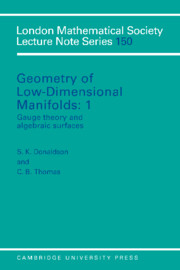Book contents
- Frontmatter
- Contents
- Contributors
- Names of Participants
- Introduction
- Acknowledgments
- PART 1 FOUR-MANIFOLDS AND ALGEBRAIC SURFACES
- PART 2 FLOER'S INSTANTON HOMOLOGY GROUPS
- PART 3 DIFFERENTIAL GEOMETRY AND MATHEMATICAL PHYSICS
- 11 Skyrme fields and instantons
- 12 Representations of braid groups and operators coupled to monopoles
- 13 Extremal immersions and the extended frame bundle
- 14 Minimal surfaces in quaternionic symmetric spaces
- 15 Three-dimensional Einstein-Weyl geometry
11 - Skyrme fields and instantons
Published online by Cambridge University Press: 16 February 2010
- Frontmatter
- Contents
- Contributors
- Names of Participants
- Introduction
- Acknowledgments
- PART 1 FOUR-MANIFOLDS AND ALGEBRAIC SURFACES
- PART 2 FLOER'S INSTANTON HOMOLOGY GROUPS
- PART 3 DIFFERENTIAL GEOMETRY AND MATHEMATICAL PHYSICS
- 11 Skyrme fields and instantons
- 12 Representations of braid groups and operators coupled to monopoles
- 13 Extremal immersions and the extended frame bundle
- 14 Minimal surfaces in quaternionic symmetric spaces
- 15 Three-dimensional Einstein-Weyl geometry
Summary
ABSTRACT The first part of this paper is a brief review of the Skyrme model, and some of the mathematical problems it raises. The second part is a summary of the proposal by M.F. Atiyah and the author to derive families of Skyrme fields from Yang-Mills instantons.
THE SKYRME MODEL
Hadronic physics at modest energies (a few GeV) is concerned with the interactions of nucleons (protons and neutrons) and of pions. About 30 years ago, Skyrme suggested a model for these particles which is still useful (Skyrme, 1962), despite the fact that the particles are now believed to be bound states of quarks. In the Skyrme model only the pion field appears, and the nucleons are quantum states of a classical soliton solution of the pion field equations, known as the Skyrmion.
Nucleons have baryon number 1, their antiparticles have baryon number −1, and pions have baryon number 0. In any physical process the total baryon number is unchanged. In the Skyrme model, a field configuration has a conserved integral topological charge which Skyrme identified with the baryon number. The Skyrmion has charge 1, and there is a similar solution with charge −1.
Skyrme's pion field is a scalar field U taking values in SU(2). I shall mainly considerfields at a given time, and not discuss dynamics much. In this case, U is a map from physical space R3 to SU(2).
- Type
- Chapter
- Information
- Geometry of Low-Dimensional Manifolds , pp. 179 - 190Publisher: Cambridge University PressPrint publication year: 1991



